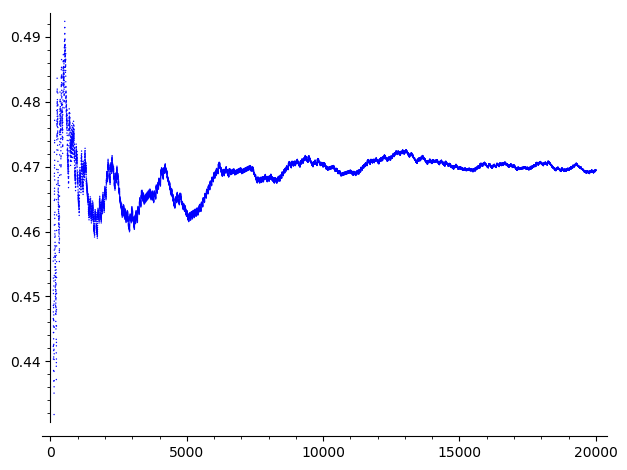This post makes a focus on a very specific part of that long post. Consider the following map:
$$f: n \mapsto \left\{
\begin{array}{ll}
\left \lfloor{n/\sqrt{2}} \right \rfloor & \text{ if } n \text{ even,} \\
\left \lfloor{n\sqrt{2}} \right \rfloor & \text{ if } n \text{ odd.}
\end{array}
\right.$$
Let $f^{r+1}:=f \circ f^r$, consider the orbit of $n=73$ on the iterations of $f$, i.e. the sequence $f^r(73)$: $$73, 103, 145, 205, 289, 408, 288, 203, 287, 405, 572, 404, 285, 403, 569, 804, 568, 401, \dots$$ Now consider the probability of the $m$th first terms of the sequence $f^r(73)$ to be even: $$p_{0}(m):= \frac{|\{ r<m \ | \ f^r(73) \text{ is even}\}|}{m}.$$ Then $p_1(m):=1-p_0(m)$ is the probability of the $m$th first terms of $f^r(73)$ to be odd.
If we compute the values of $p_i(m)$ for $m=10^{\ell}$, $\ell=1,\dots, 5$, we get something unexpected: $$\scriptsize{ \begin{array}{c|c} \ell & p_0(10^{\ell}) &p_1(10^{\ell}) \newline \hline 1 &0.2&0.8 \newline \hline 2 &0.45&0.55 \newline \hline 3 &0.467&0.533 \newline \hline 4 &0.4700&0.5300 \newline \hline 5 &0.46410&0.53590 \end{array} }$$ It seems that $p_0(m)$ does not converge to $1/2$, but that $p_0(m) \sim 46.5\%$ and $p_1(m) \sim 53.5\%$
Question: Is it true that $p_0(m)$ does not converge to $1/2$?
Assume that it converges, let $\alpha$ be its limit. Is $\alpha$ close to $0.465$? What is its exact value?
The following picture provides the values of $p_0(m)$ for $100 < m < 20000$:
 Note that this phenomenon is not specific to $n=73$, but seems to happen as frequently as $n$ is big, and then, the analogous probability seems to converge to the same $\alpha$. If $n <100$, then it happens for $n=73$ only, but for $n<200$, it happens for $n=73, 103, 104, 105, 107, 141, 145, 146, 147, 148, 149, 151, 152, 153, 155, 161, 175, 199$. And for $10000 \le n < 11000$, it happens to exactly $954$ ones.
Note that this phenomenon is not specific to $n=73$, but seems to happen as frequently as $n$ is big, and then, the analogous probability seems to converge to the same $\alpha$. If $n <100$, then it happens for $n=73$ only, but for $n<200$, it happens for $n=73, 103, 104, 105, 107, 141, 145, 146, 147, 148, 149, 151, 152, 153, 155, 161, 175, 199$. And for $10000 \le n < 11000$, it happens to exactly $954$ ones.
Below is the picture as above but for $n=123456789$:

Alternative question: Is it true that the set of $n$ for which the above phenomenon happens has natural density one? Is it cofinite? When it happens, does it involves the same constant $\alpha$?
